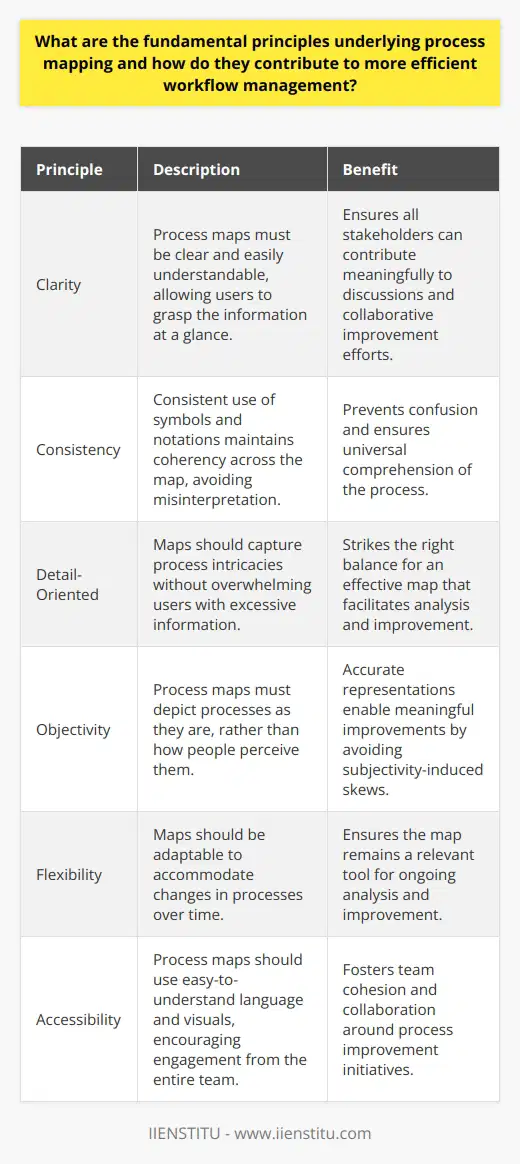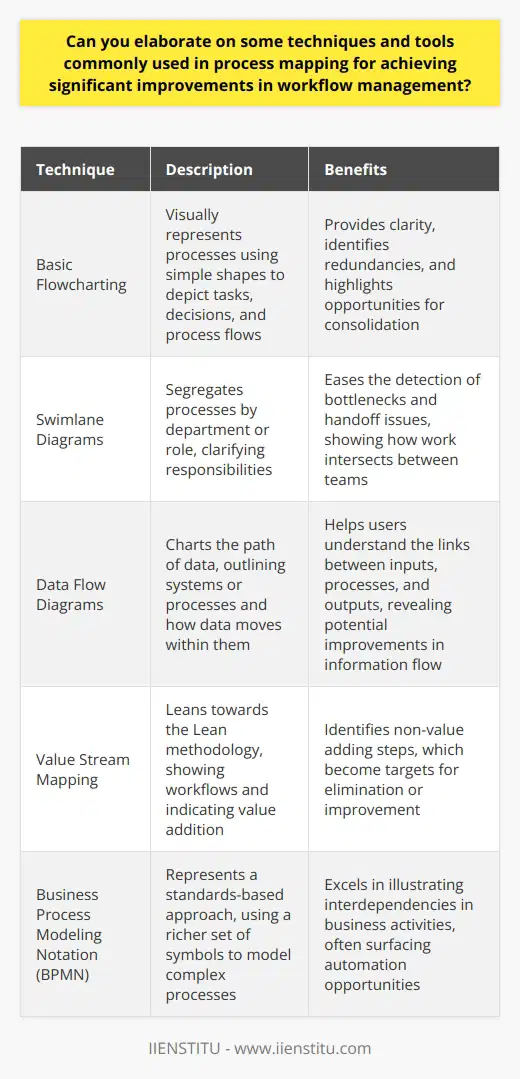
In the fabric of modern organizational operations, process mapping stands as an essential methodology for charting a course towards optimal workflow efficiency. Through a visual representation of how tasks are completed and how information flows within an organization, process mapping provides invaluable insights into the functional anatomy of business processes.
Understanding the sequential steps and interactions necessary to perform a task not only lays the groundwork for clear communication but serves as a benchmark for ongoing improvement. Given the fast-paced nature of today's business environment, process mapping is no longer a luxury but a fundamental expectation in the pursuit of organizational success.
Understanding Process Mapping: An Overview
Define Process Mapping
Process mapping is the strategic act of diagramming the steps involved in a workflow to achieve greater clarity on how a process operates. It extends beyond the mere sketching of steps to encompass the identification of roles, responsibilities, and critical junctures where inputs become outputs.
The graphical representation it produces allows for a versatile and comprehensible approach to understanding complex systems. This visual guide assists in revealing redundancies, inefficiencies, and opportunities for optimization.
Discuss Its Key Elements
The key elements of process mapping include tasks, sequences, actors, decision points, and flow of information. Each task is represented as a step in the map, often depicted as a shape, such as a rectangle or an oval. Sequences illustrate the order in which tasks occur, typically through arrows or directional lines.
Actors, who are individuals or groups responsible for steps, are denoted in the map, emphasizing accountability and ensuring clarity. Decision points are critical as they represent crossroads where one or several paths can be taken, further influencing the task flow.
Highlight Its Main Objectives
At its core, process mapping aims to provide an exhaustive and transparent depiction of a process, serving three main objectives: operational transparency, efficiency optimization, and facilitating communication and understanding among stakeholders.
By achieving these objectives, organizations can streamline their operations, improve performance, and maintain an edge in an ever-growing competitive landscape.
The Benefits of Process Mapping
Improved Operational Efficiency
A clear outcome of process mapping is the enhancement of operational efficiency. By visually capturing processes, inefficiencies become more apparent, enabling organizations to target and eliminate waste. It also pinpoints where automation can replace manual work, freeing up valuable resources and increasing the organization's operational pace.
Identification of Bottlenecks and Process Imbalances
An important advantage of process mapping is the identification of bottlenecks and imbalances in workflow. These are the spots in the process where delays occur, resources are overtaxed, or where information sits idle awaiting action. Once identified, organizations can realign resources or alter the process design to alleviate such pressure points.
Enhanced Communication and Collaboration
It has been widely recognized that process mapping fosters enhanced communication and collaboration across departments. With a clearly illustrated map, all stakeholders have a common understanding of the process. This shared visual tool aids in discussions, training, and aligning the organization towards a cohesive operation.
The Steps Involved in Process Mapping
Identifying the Process to Map
The initial step in process mapping is to pinpoint the specific process that requires examination. This requires understanding the scope and boundaries of the process and discerning why it is critical to the business's functioning. A well-chosen process for mapping is usually one with significant impact on performance or customer satisfaction.
Gathering Detailed Information About the Process
Once the process is identified, the next stage is to gather detailed information about each step. This involves interviewing stakeholders, reviewing process documentation, and understanding the inputs and outputs at each stage. A thorough information collection phase is crucial for an accurate depiction of the process.
Designing the Process Map
With all the necessary information on hand, the actual design of the process map takes place. Here, the use of standardized symbols and a logical flow is important to ensure that the map is easily understandable. Tools like flowcharts, mind maps, or diagrams come into play, providing a structure to the gathered data.
Analysis of the Designed Process Map
Following the creation of the map, the analysis phase begins. This involves reviewing the process critically to identify gaps, redundancies, and areas for improvement. During this phase, assumptions are tested, and the real-life application of the process is compared against the theoretical model.
Improving the Process Based on the Analysis
Finally, the culminating step is to make improvements to the process based on the analysis of the process map. This may involve redesigning steps, introducing new technologies, or altering responsibilities. The goal is to fine-tune the process to ensure it operates at peak efficiency and effectiveness.
Illustrating Process Mapping with Real-World Examples
Process Mapping in Manufacturing
In manufacturing, process mapping has been instrumental in streamlining production lines. For instance, in an automotive assembly plant, process maps can uncover redundant quality checks or identify where the sequence of assembly can be reconfigured to reduce time to market.
Process Mapping in Healthcare
The healthcare sector utilizes process mapping to enhance patient care. Hospitals often employ this method to streamline patient admissions, discharge procedures, or emergency response times, directly impacting the quality of service and patient satisfaction.
Process Mapping in Software Development
In software development, process mapping allows teams to visualize the software development lifecycle (SDLC). This clear depiction aids in identifying stages where additional testing might be required or where resource allocation needs adjustment to meet project timelines.
Top Process Mapping Techniques
The Flowchart Method
One of the most commonly used techniques is the flowchart method. It uses a series of symbols and arrows to represent the sequence of steps, decisions, and the flow of information. Flowcharts are versatile and widely accepted across different industries due to their simplicity and clarity.
Swim Lane Diagrams
Swim lane diagrams partition the process map into lanes, usually representing different departments or roles within the organization. This situation highlights the interaction between different parties involved in the process and is beneficial for identifying cross-departmental workflow issues.
Value Stream Mapping
Value stream mapping focuses on the value-adding and non-value-adding activities in a process, with a strong leaning towards lean manufacturing principles. It highlights inefficiencies and helps in creating solutions that streamline production and minimize waste.
Cross-functional Flowcharts
Cross-functional flowcharts are similar to swim lane diagrams but provide a more detailed look at which specific roles are responsible for each step in the process. This level of detail is extremely helpful in complex processes that require a high degree of coordination across various teams or departments.
Utilizing Software Tools for Process Mapping
Discussion of Modern Software Tools
In the digital age, numerous software tools have been developed to facilitate process mapping. These tools offer a range of functionalities from simple drawing to complex data analytics. They enable users to create dynamic process maps that can be easily shared and updated, making them a powerful alternative to paper-based mapping.
Benefits of Using Software Tools Over Traditional Methods
Using software tools for process mapping presents multiple advantages over traditional manual methods. These include the ability to easily revise and maintain maps, better collaboration features enabling real-time updates and feedback, and sophisticated analysis capabilities that can automatically identify inefficiencies and simulate process changes.
Common Mistakes in Process Mapping and How to Avoid Them
Overcomplicating the Map
A prevalent mistake in process mapping is overcomplication. Too many details can obscure the overall view of the process, making it difficult to identify critical pathways and actions. The map should be as simple as possible while still conveying all necessary information.
Leaving Out Vital Process Steps
Omitting crucial steps is another common error. Every action, no matter how minor it may seem, can impact the flow of the process. Thus, it's imperative to verify that the map is complete through checks with multiple stakeholders.
Not Involving the Right People in the Mapping Process
Process mapping requires the input of those who are intimately familiar with the process. Failing to involve the correct personnel can lead to a map that does not accurately reflect reality. A diverse and inclusive team of mappers ensures a more accurate and functional outcome.
In summing up, process mapping is an indispensible technique for organizations aiming to refine their operations and soar towards higher levels of efficiency and effectiveness. By charting out every nuance of a process, businesses can unveil opportunities for improvement, foster greater understanding of workflows and bolster team collaboration.
With the advent of online certificate courses in areas such as problem solving certification, the skills to proficiently map and analyze business processes are more accessible than ever. Organizations are encouraged to embrace process mapping, fully harnessing its benefits to navigate the complex landscape of today’s dynamic business environment.
Frequently Asked Questions
What are the fundamental principles underlying process mapping and how do they contribute to more efficient workflow management?
Process mapping functions as a cornerstone in the domain of workflow management. This practice involves constructing detailed diagrams. These diagrams reveal the dynamic flows of a given process. These flows can involve multiple elements. They typically include tasks, actors, and informational exchanges. By laying out these components, process mapping aids in the visual understanding of workflows. This understanding is crucial to identify inefficiencies and potentials for improvement.
Fundamental Principles of Process Mapping
Clarity
Above all, process maps must be clear. They require simple representation of complex processes. Users should grasp the information at a glance. Clarity ensures that all stakeholders can contribute meaningfully to discussions. This is vital for collaborative improvement efforts.
Consistency
Consistency in symbols and notations is non-negotiable. It maintains coherency across the map. Users should not confuse one element for another. Consistent representation avoids misinterpretation and ensures universal comprehension.
Detail-Oriented
A process map must be detail-oriented yet not overwhelming. It should capture the intricacies of the process. At the same time, it must not cloud the map with excessive information. Striking the right balance is key to an effective map.
Objectivity
Maps must depict processes as they are, not how people perceive them. This requires objectivity. Subjectivity can lead to skewed representations. Thus, inaccurate maps can hinder meaningful improvements.
Flexibility
A process map must be adaptable. Processes can change over time. The map should accommodate these changes. This ensures it remains a relevant tool for analysis and improvement.
Accessibility
Process maps should be widely accessible. This includes easy-to-understand language and visuals. It encourages engagement from the entire team. Team cohesion around process improvement is therefore fostered.
Contribution to Workflow Efficiency
By adhering to these principles, process mapping drives efficiency in several ways.
Identification of Redundancies
Detail-oriented maps reveal unnecessary duplications. Eliminating these redundancies streamlines the workflow. Efficiency gains are the natural consequence.
Eradication of Bottlenecks
When maps highlight bottlenecks, stakeholders can address them directly. They can devise strategies to smooth out the workflow. This reduces delays and improves overall efficiency.
Enhanced Communication
Clarity and consistency in maps enhance team communication. When everyone understands the process, coordination improves. This removes misunderstandings that could otherwise hinder the workflow.
Strategic Planning
Accessible and adaptable process maps support better planning. They become a reference for future changes and process reengineering.
Continuous Improvement
An objective process map provides a factual basis for continuous improvement initiatives. It incites periodic analysis and revisions. This cycle ensures a workflow remains efficient and responsive to change.
In conclusion, process mapping is not merely an organizational tool. It underpins a strategic approach to managing workflows. By following its fundamental principles, organizations can cut through complexity. They can unveil opportunities for significant efficiency gains. Employing process mapping, businesses can foster dynamic, lean, and responsive working environments.

How can process mapping be effectively utilized to identify bottlenecks and issues in current workflows?
The Importance of Process Mapping
Process mapping stands as a critical tool. It dissects business workflows. It elucidates each step comprehensively. Stakeholders scrutinize mapped processes keenly. They discern inefficiencies and bottlenecks. Understanding workflow intricacies becomes simpler. Mapping enables visualization of the entire process.
Clarify Complex Processes
Organizations often tackle complex operations. Without proper documentation, confusion may reign. Process maps bring clarity. They depict workflows with simple symbols. Lines and arrows guide the viewer's understanding.
Identifying Bottlenecks
Bottlenecks hinder workflow efficiency. Process mapping shines a light on these. It helps teams spot where tasks stall. Delays become obvious. Work piles up at certain points. High-traffic areas indicate possible inefficiencies. Stress on resources becomes tangible.
Analyzing Issues
Process maps do more than reveal bottlenecks. They highlight redundant steps. They expose unnecessary complexity. Inconsistencies become apparent. Maps provide a framework for critical analysis. Issues surface through comparative studies. Best practices emerge.
Steps to Effective Utilization
Step 1: Gather Detailed Information
Comprehensive data collection is essential. Equip teams with detailed workflow information. Include every task and decision point.
Step 2: Select Appropriate Mapping Tools
Choose tools that suit your needs. Software options abound. Select user-friendly, feature-rich platforms.
Step 3: Map the Current State
Document the existing process. Involve employees who perform daily tasks. Their insights prove invaluable.
Step 4: Analyze for Bottlenecks and Issues
Examine the mapped process. Look for areas of congestion. Identify steps that cause delays. Note where confusion or errors occur.
Step 5: Optimize the Workflow
Develop strategies to eliminate bottlenecks. Streamline or automate repetitive tasks. Improve communication channels.
Step 6: Implement and Monitor Changes
Introduce improvements gradually. Track the impacts of these changes. Obtain feedback from those involved.
Step 7: Continual Improvement
Treat process improvement as ongoing. Revise maps as workflows evolve. Ensure adaptations reflect current practices.
Benefits of a Mapping-Driven Approach
Enhanced visibility fosters informed decision-making. Teams can pinpoint areas for improvement. Process mapping promotes transparency. It ensures that all stakeholders understand workflows.
Efficiency increases. Streamlined processes save time and resources. Employees focus on value-adding activities. Unnecessary steps fall to the wayside.
Improved performance follows. Bottleneck elimination enhances throughput. Customer satisfaction can rise. Faster delivery times become possible. Quality often improves.
In conclusion, process mapping is not just a tool. It is the bedrock of continuous improvement. With effective use, teams identify, analyze, and resolve workflow issues. The steps outlined offer a path to harnessing its full potential. Embrace process mapping. Yield tangible results. Witness the transformation in operational efficiency.

Can you elaborate on some techniques and tools commonly used in process mapping for achieving significant improvements in workflow management?
Process Mapping Techniques
Process mapping serves as a pivotal tool in workflow management. It delineates processes, enabling critical analysis and improvement. Businesses adopt various techniques and tools in this endeavor. The goal remains constant: streamline workflows for efficiency and effectiveness.
Basic Flowcharting
A fundamental technique is flowcharting. It visually represents processes, highlighting the sequence of actions. Simple shapes depict tasks, decisions, and process flows. Clarity emerges. Analysts and stakeholders identify redundancies and opportunities for consolidation.
Swimlane Diagrams
Swimlane diagrams offer a deeper look. They segregate processes by department or role. This division clarifies responsibilities. It eases the detection of bottlenecks and handoff issues. Teams can see how their work intersects with others.
Data Flow Diagrams
Data flow diagrams chart the path of data. They outline systems or processes and how data moves within them. Users understand the links between inputs, processes, and outputs. Potential improvements in information flow become apparent.
Value Stream Mapping
Value stream mapping leans towards the Lean methodology. It not only shows workflows but also indicates value addition. Non-value adding steps stand out. They become targets for elimination or improvement.
Business Process Modeling Notation (BPMN)
BPMN represents a standards-based approach. It uses a richer set of symbols to model complex processes. It excels in illustrating interdependencies in business activities. Automation opportunities often surface with BPMN.
Tools for Effective Process Mapping
A multitude of tools complement these techniques. They range from basic to advanced. Most aim for user-friendliness and collaboration.
Paper and Whiteboards
Paper and whiteboards represent the traditional tools. They invite collaboration. Ideas flow freely. However, they lack persistence and are hard to share widely.
Microsoft Visio
Microsoft Visio stands out as a popular digital tool. It allows detailed mapping with a wide array of shapes and symbols. Collaboration happens through cloud sharing.
Lucidchart
Lucidchart offers a web-based alternative. It supports real-time collaboration. Teams across different locations access, edit, and comment on diagrams. It integrates with other workplace tools.
Bizagi Modeler
Bizagi Modeler caters to BPMN aficionados. It furnishes advanced process modeling capabilities. Simulations can forecast the impact of changes.
ARIS
ARIS is a professional-grade suite. It targets enterprise-level process optimization. Comprehensive analysis features guide significant workflow enhancements.
Conclusion
Organizations use these techniques and tools to craft roadmaps for process improvement. Structured process mapping leads to more informed decisions. Enhanced workflow management results in efficiency gains. Businesses become more responsive and agile. In essence, proficient process mapping practices lay the groundwork for continuous operational excellence.



